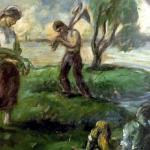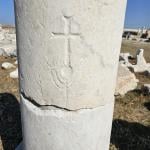I tentatively continue on the makeup of man, from some previous seminary research.[1] Ancient Israel and the Hebrew Bible seems to teach that we are not a sum total of parts, but rather a whole.
The Ancient Greeks develop somewhat of a dichotomy between the material and the spiritual, at least among the Aristotelians and Gnostics. We know that in our day, there is still at least one major proponent of dualism, Tony Bennett. No one can sing “Body and Soul” better!
In Christian circles today, from what historical basis I do not know, we often teach a type of trichotomy: body, soul, and spirit.
There is some Biblical merit in examining these three words. However, I still believe there is a holism that we often overlook.
No matter your view, there is undeniably a change in the interior man, if you believe in salvation at all. It is to this mystery that we now turn.
Adam: Spirit
Breath
After molding Adam from the clay, God, “breathed into his nostrils the breath of life” (Genesis 2.7, King James Version). The context sets these words apart. God directly blows into Adam’s nostrils. He does nothing of the sort with the rest of creation.
“The ‘breath of life’ may simply mean God’s breath or Spirit which produces life, which gives man his ‘life-breath’ or ‘faculty of life.’”[2]
Spirit
At least three Old Testament writers use the word breath to describe man’s spirit, which comes from God, and returns to God (Job 26.4, Proverbs 20.27, Isaiah 42.5).
In the Greek, the distinction is not so clear. The word pneuma is used for both breath and spirit. It is the basis of the word Pneumatology, or the study of the Holy Spirit.
Some theologians believe that man’s spirit is the same as his soul. Others believe that the spirit and the soul are distinct parts of man’s inner being.
The biblical term spirit, however, seems to refer to the deepest part of my essential nature as a person. When I think about the deepest part of me – the part that has the capacity for fellowship with God – I am reflecting on my spirit.[3]
Adam’s Fall: from Spirit to Death
Genesis 3.7 states that after taking the fruit, “the eyes of them both were opened.” They realize they are sinful and naked. In that moment, there is a change in their spirit.
God promises that they will die in the day they take the fruit (Genesis 2.17). They do not physically die until hundreds of years later. However, they experience a change in their essence.
Jones and Butman write, “Individual sins testify that we have a ‘sin nature,’ which predisposes us to individual acts of violation against God’s law.”[4]
Sin is an act that is the result of a fallen nature . . . original sin. Our fallen spirit, by its very nature, separates us from God and is in a death-like state.
The 2nd Adam: from Death to Life by the Holy Spirit
The Holy Spirit raises Jesus Christ from the dead (Romans 8.11). Jesus appeared to His disciples and, “he breathed on them, and saith unto them, Receive ye the Holy Ghost” (John 20.22).
Whips break Christ’s body so that man’s body can be healed and restored. Thorns and nails pierce Him, opening a flow of blood that cleanses and forgives. He dies for us.
However, He also lives for us. When He breathes again, He shares His breath with The Twelve. And Christ still breathes on His disciples today, like God originally breathes into the nostrils of Adam.
Thomas Northcut | Woman against black background | gettyimages
Christ breathes and imparts the Holy Spirit into all His followers. The fallen spirit of man is re-awakened by the indwelling of the Spirit.
The minister or counselor has a distinct advantage in the care of Christian souls. Christians are living as a new creation (2 Corinthians 5.17).
John Ingram states, “The person’s new identity is in Christ, which can be experientially activated by utilizing the power of the Holy Spirit.”[5]
On the other hand, the parishioner or client who is not regenerated, must rely on mere human efforts to change.
Questions to Consider:
1. Does your church hold to a specific teaching about the nature of man? What does you congregation teach about conversion? What aspect of man is changed or transformed at conversion?
2. Is there another point in the Scriptures where you believe the Disciples have their conversion experience? What makes John 20 a passage to consider?
3. What responsibility do we have to develop an understanding of salvation as ministers? As therapists? Or as anyone who cares for souls? And as Christians?
4. For my heady Theologian friends who may be reading, do we allow our subfields of Soteriology, Christology, and Pneumatology to converge in studies like this, and in Scriptures like John 20? How would a more robust Pneumatology affect our understanding of the Passion, Resurrection, and initial salvation experience?
[1] Jared V. Ingle, “Nine Biblical Factors of Personality, Abnormality, and Change in the Creation Account,” (paper presented in Interpersonal Techniques in Helping Relationships, Assemblies of God Theological Seminary, Springfield, MO, December 9, 2003).
Toward a Biblical Concept of Personality
On Holism, Holiness, and Wholeness
The Image, the Body, and Renewal
[2] Stanley Horton, What the Bible says about the Holy Spirit (Springfield, MO: Gospel Publishing House, 1976), 22.Amazon: What the Bible Says About the Holy Spirit [3] Larry Crabb, The Marriage Builder: A Blueprint for Couples and Counselors (Grand Rapids, MI: Zondervan Publishing House, 1992), 27.
Amazon: The Marriage Builder [4] Stanton Jones and Richard Butman, Modern Psychotherapies: A Comprehensive Christian Appraisal (Downers Grove, IL: InterVarsity Press, 1991), 50.
Amazon: Modern Psychotherapies [5] John A. Ingram, “Psychological Aspects of the Filling of the Holy Spirit: A Preliminary Model of Post-Redemptive Personality Functioning,” Journal of Psychology and Theology24, no. 2 (1996), 105.













